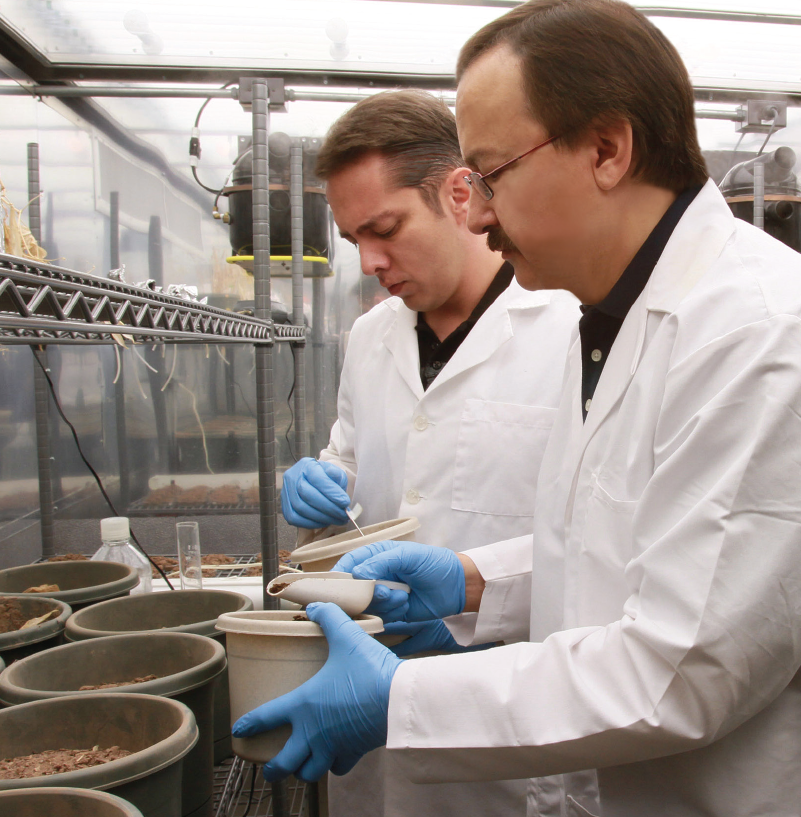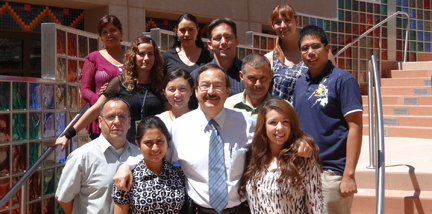By Nadia Macias
UTEP News Service
Although we can’t see them, tiny manmade nanoparticles are all around us – in our makeup, sunscreen, fuel, and even powdered donuts.
And the number of nanoparticles is only going to increase.
With a diverse range of potential applications, engineered nanoparticles are being used more and more to create novel technologies and medicines. For instance, in sunscreen, titanium dioxide and zinc oxide nanoparticles are used to protect against both UVA and UVB rays.
Between 2006 and 2011, reports showed that the number of nanotechnology-related products worldwide grew by 521 percent. By 2015, the market for nanoproducts is expected to hit $2.4 trillion, according to a study by Global Industry Analysts Inc.

Jose Hernandez-Viezcas, left, and Jorge Gardea-Torresdey, Ph.D., chair of UTEP’s chemistry department, have iscovered that engineered anoparticles that land in soil can be bsorbed by plants and are entering the food supply via crops grown for human consumption.
Despite this rapid increase, scientists don’t yet know how these manufactured nanomaterials are affecting the environment and humans, and whether or not further regulations are needed on nanomaterial production.
For the past few years, Jorge Gardea-Torresdey, Ph.D., Dudley Professor of Chemistry and Environmental Science and Engineering, and chair of the Department of Chemistry at UTEP, has studied how manufactured nanomaterials can get into the environment via fuel fumes and wastewater runoff, and ultimately, land in soil and affect plant life.
Funded by $24 million from the National Science Foundation and the Environmental Protection Agency, Gardea-Torresdey is a co-investigator of the University of California Center for Environmental Implications of Nanotechnology (UC CEIN).
The team recently turned its attention to soybeans, the second largest crop in the United States; cucumbers; and three manufactured metal nanomaterials in particular: zinc oxide, cerium oxide, and titanium oxide.
“When we got the grant from the NSF and EPA, we selected the nanoparticles that are used and produced the most,” Gardea-Torresdey said. “These are produced in millions of tons.”
For instance, titanium oxide is used to enhance sunscreens, toothpaste, antibacterial and antiviral disinfectants, solar cells, skim milk, and paints.
The team tested the effects of zinc oxide and cerium oxide on about 100 soybean plants that were grown at the University of California, Santa Barbara under the direction of Patricia Holden, Ph.D., professor of environmental microbiology. Different concentrations of the nanomaterials were placed in the plant’s soil – the idea being that the plants would absorb them.
After the plants were fully grown, they were shipped to UTEP, where Gardea-Torresdey and his team studied the concentration and biochemical effects of the nanomaterials, among other things.
One key question was whether or not the nanomaterials had broken down once the plant absorbed them, or if they remained a metal oxide nanoparticle, which could potentially have effects on the plants and humans if consumed.
“My role was to determine how much was taken up by the plant,” said Jose Hernandez-Viezcas, a doctoral chemistry student at UTEP who used plasma spectroscopy and synchrotron advanced techniques to make the scientific observations. “In this experiment, we found that the plants do uptake the metal. In other words, we found high concentrations of zinc in the pods, stems and leaves.”
The study showed that the zinc oxide had broken down to zinc, while the cerium oxide remained a manufactured nanoparticle when it was absorbed.
The unbroken cerium oxide led to a lower yield of soybeans and affected the legume’s ability to act as a natural fertilizer, suggesting that synthetic fertilizers would need to be increased in legume crops affected by cerium oxide.
“Cerium oxide didn’t break down, and that’s the problem,” Gardea-Torresdey said. “It’s going to go into the food chain, and go into humans that eat them. We saw before in another [research] paper genetic DNA damage that can create new genes upon exposure to cerium oxide, and so people who eat this could have genetic damage down the road, but we’re not sure yet.”
These results were recently published by the U.S. National Academy of Sciences flagship journal, Proceedings of the National Academy of Sciences, and featured by PerkinElmer, a world leader in analytical instrumentation and services.
In the case of the cucumbers – published in the journal Environmental Science and Technology – the effect of titanium oxide nanoparticles was tested on about 200 grown in UTEP’s growth chambers. At harvest, the plants’ root length showed a significant increase of 300 percent.
With the help of the European Synchrotron Radiation Facility in France, x-ray spectromicroscopy experiments were performed on the cucumber plant.
Similar to cerium oxide in soybeans, the titanium oxide nanoparticles were found unbroken upon absorption. In addition, analysis showed that the nanoparticles had been absorbed and transferred all the way from the roots to the leaf hairs.
“Plants have defense mechanisms, so sometimes when they sense a toxic agent, they take it all the way to the trichomes (leaf hairs) to excrete them,” Gardea-Torresdey said. “So maybe what the cucumbers are doing is excreting it so it does not affect them.”
Andre Nel, director of UC CEIN and division chief of nanomedicine at the University of California, Los Angeles, specializes in nanomedicine and nanobiology, including the study of nanomaterial properties that lead to biocompatible and biohazardous interactions in humans.
“If I have to tell you if any of those three [nanomaterials] have been shown to cause any health affects on humans that is clearly documented or confirmed, the answer is no,” he said. “But, if you ask the question, ‘Are there experimental data out there that show these materials, in some settings, could be hazardous?’ then the answer is yes.”
Nel has been studying the effect of these nanomaterials on different cells and animals, such as mice and zebra fish, in order to find which nanomaterials are potentially hazardous and need safety implementation measures.
“In a nutshell, nanomaterials have amazing effects in terms of their industrial use potential,” he said. “But because engineered nanomaterials are relatively new materials with new properties, it’s important that we study their possible impact on humans and understand whether they might interact with the biology of humans, plants and other organisms in the environment.”
According the Gardea-Torresdey, there are more than 1,400 nanomaterials produced in the market today, meaning many more tests on food crops and manufactured nanoparticles are needed to understand the full effect nanotechnology is having on the environment and humans.
For doctoral student Hernandez-Viezcas, the research has opened his eyes to a potential danger that he didn’t even know existed before.
“Since I have been doing this research for five years now, I’ve become very conscious about the subject,” Hernandez-Viezcas said. “[Humans] end up being exposed to all these things, and we assume we’re protected, but we’re not. Maybe in the future this will help to make some laws on regulating nanoparticles.”
